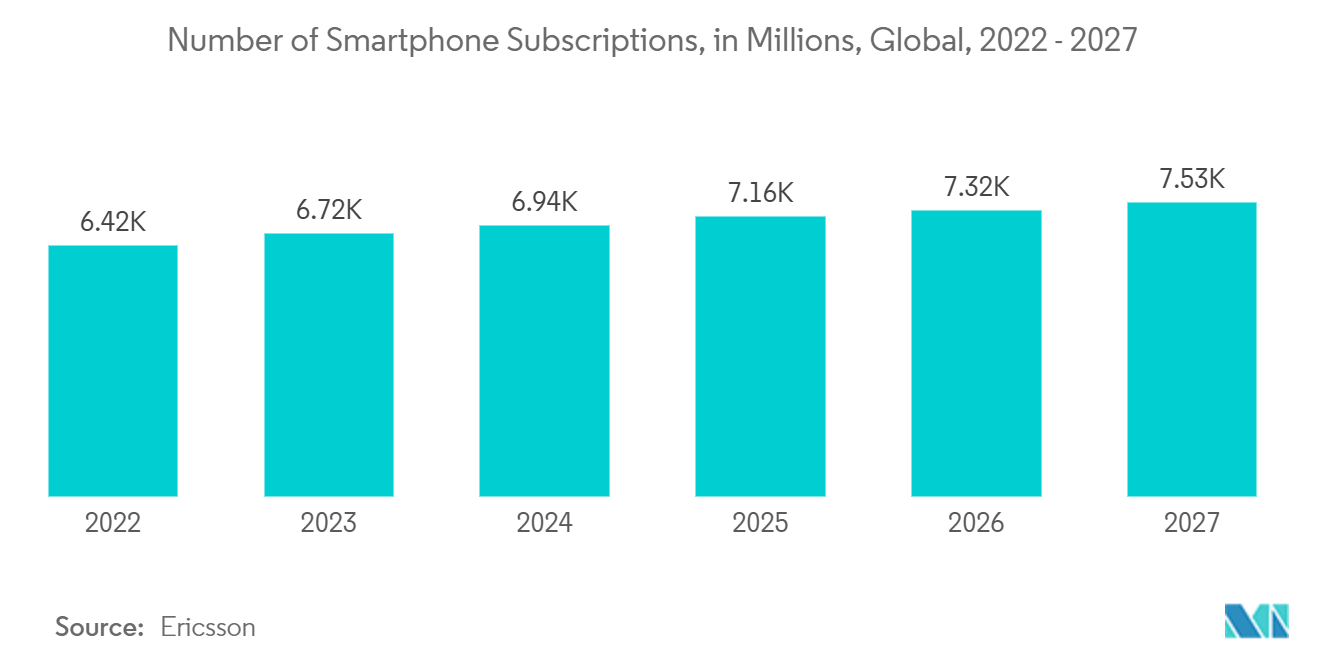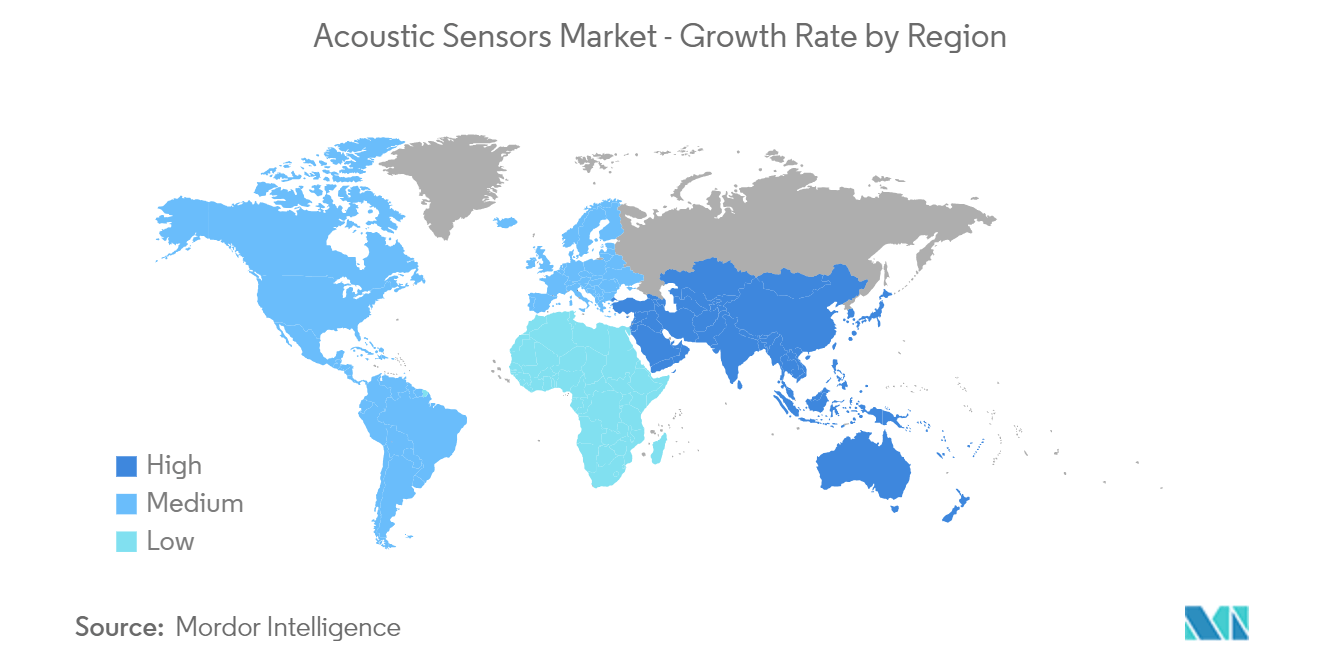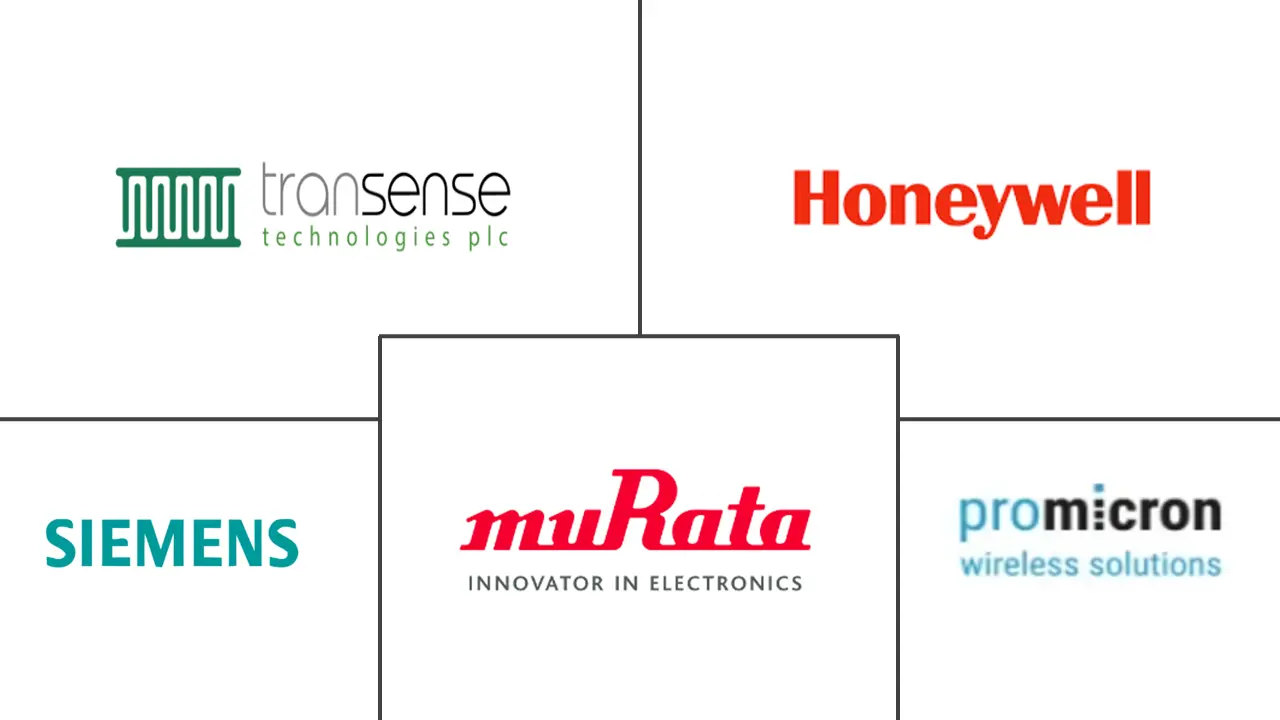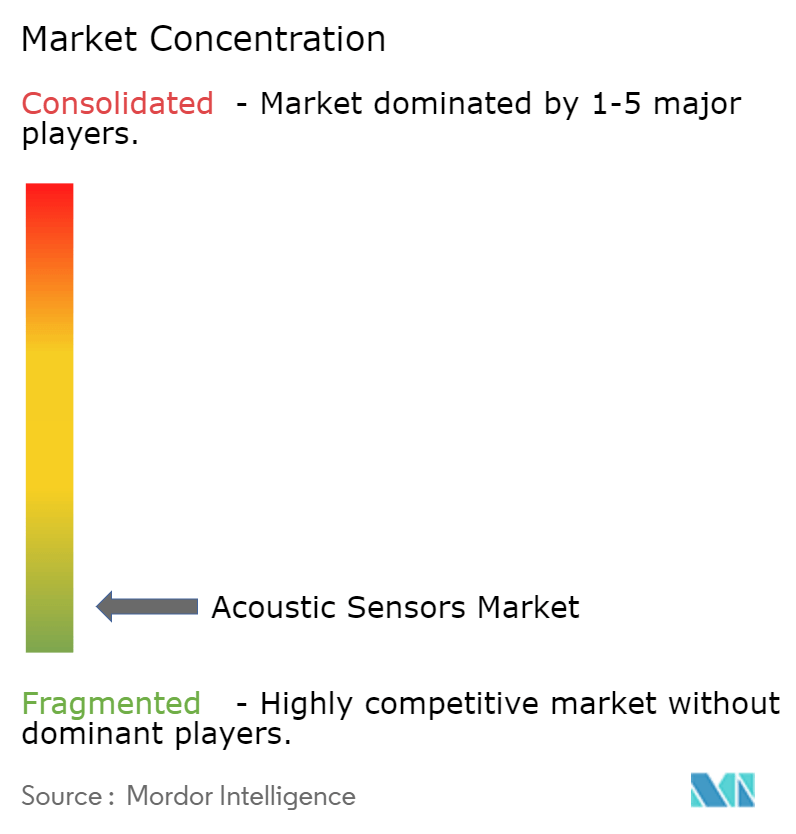
Acoustic Sensors Market Analysis
The Acoustic Sensors Market size is estimated at USD 1.80 billion in 2025, and is expected to reach USD 2.77 billion by 2030, at a CAGR of 9.01% during the forecast period (2025-2030).
- Most people use camera-based sensing. Research has focused on RF-based approaches for their ease and lack of intrusion. Because RFID doesn't require batteries, it is frequently used in corporate operations like supply chain management and storage. Furthermore, WiFi-based sensing approaches have been shown to be quite effective in integrating sensing functions in a smart home or workplace due to the widespread availability of indoor WiFi infrastructures.
- Acoustic signals offer a third dimension for sensing in addition to camera- and RF-based solutions since microphones and speakers are increasingly often found in mobile, wearable, and smart appliance devices. For noise reduction and far-field speech pickup, the Galaxy Note 3 and Amazon Echo include numerous sophisticated microphones built into them. Both the Galaxy S9 and Google Home have multiple stereo speakers. Additionally, many mobile devices now offer high recording quality (such as 192 kHz) aimed at audiophiles, which has significantly improved acoustic-based detection capabilities.
- Furthermore, advancement in the communication industry is boosting the overall acoustic sensor market. According to GSMA, As of January 2024, 47 operators have rolled out commercial 5G services on Standalone (SA) networks. Additionally, over half of these operators anticipate implementing 5G-Advanced within a year of its standard release. The surge in 5G SA and 5G-Advanced initiatives in 2024 is poised to catalyze a fresh wave of 5G investments, particularly in leading markets.
- Moreover, acoustic sensors have recently seen significant demand in automotive applications. The complete silence of the motors used in EVs may pose a hazard to inattentive pedestrians. As a result, the latest electric and hybrid cars will have to be equipped with an acoustic warning system. Therefore, rising concerns regarding traffic management will drive market growth. According to UBS, the global market for sensor semiconductors in autonomous vehicles is anticipated to reach USD 30 billion by 2030. Changes in automotive trends may lead to potential growth for acoustic sensors for automotive applications during the forecast period.
- Various companies are investing in Acoustic sensors due to their deployment in smart devices that can be used in diverse fields like environmental monitoring of toxic and hazardous vapors in defense applications, food analysis and control, engine oil aging, microorganism, and healthcare applications like cancer cell detection. For instance, in In July 2024, Tesla unveiled its intentions to introduce an automated ride-hailing service, contingent on resolving self-driving technology. Tesla's patent details a sophisticated sensor array, encompassing image, acoustic, thermal, pressure, capacitive, radio frequency, and gas sensors, to monitor the vehicle's interior environment. such instances are creating the demand for acoustic sensors from automotive industry.
- There are many technical challenges associated with acoustic sensors, such as annoying audible sound leakage and large power consumption, which can relatively reduce the battery life of battery-powered devices, and the acoustic sensing system can affect the music play and voice calls.
- Furthermore, the ongoing political pus and downs are expected to impact the electronics industry significantly. The conflict has already exacerbated the semiconductor supply chain issues and the chip shortage that have affected the industry for some time. The disruption may come in the form of volatile pricing for critical raw materials such as nickel, palladium, copper, titanium, aluminum, and iron ore, resulting in material shortages. This would obstruct the manufacturing of acoustic sensors.
Acoustic Sensors Market Trends
Consumer Electronics to Drive the Market Growth
- Acoustic sensors are widely used in consumer electronics, notably smartphones and laptops. The development of the appropriate sensors and technologies was greatly aided by consumer electronics, one of the significant investors and consumers of acoustic sensors. According to Ericsson, in Q2 of 2023, global 5G subscriptions surged by 175 million, nearing a total of 1.3 billion. China, India, and the United States have the highest smartphone mobile network subscriptions.
- In many consumer and communication applications, using sound sensors greatly aided the development of RF filters. For instance, the creation of acoustic devices is relatively straightforward. The cost of sensor materials has declined over the past three decades due to the widespread use of surface wave acoustic filters in the smartphone sector.
- Most telephones and comparable devices are equipped with microphones and speakers that facilitate acoustic-sensing applications and have a comparatively cheap implementation cost.
- Further, iIn November 2023, NEC Corporation, a leading Japanese technology firm, took the helm in expanding the Mastercard Biometric Checkout Programme across the Asia Pacific (APAC). Signing a Memorandum of Understanding, NEC and Mastercard agreed to integrate NEC's cutting-edge face recognition and liveness verification tech into the initiative, aiming to boost its uptake among APAC merchants.
- Acoustic wave technology companies have a massive opportunity to expand due to the rising production of LTE, 4G, and 5G devices, particularly 5G smartphones. Due to their ability to separate radio signals from the many spectrum bands smartphones utilize to receive and send data, RF filters are increasingly employed as standard parts in these devices.
- With the advent of 5G technology, new advanced SAW filters have more development potential since they provide a higher performance solution than competitive BAW filters in the sub-2.7 GHz frequency region. Such developments in consumer electronics may further propel the studied market growth.

Asia-Pacific to Witness a Significant Growth Rate
- The Asia-Pacific region is anticipated to grow significantly over the forecast period due to its dominance in the global semiconductor manufacturing industry. The region is also one of the global manufacturers of consumer electronics, electric vehicles, and advanced electronic devices, among others, making it one of the significant consumers of acoustic sensors globally. In 2023, the region boasted 1.45 billion mobile internet subscribers and nearly 2 billion 4G connections, as reported by GSMA. By early 2024, the region had already amassed 300 million 5G connections, marking a 10% adoption rate among subscribers.
- The region's demand for RF semiconductors is anticipated to rise due to the growing emphasis on expenditures to build infrastructure to enable 5G technology. The GSMA estimates that between 2020 and 2025, mobile operators in the Asia-Pacific region will invest more than USD 400 billion in their networks, of which USD 331 billion will go toward 5G deployments.
- Acoustic sensors are anticipated to expand throughout the projected period due to the rising use of smartphones, tablets, and other electronic devices in major and emerging countries, including the United States, China, South Korea, Japan, and India. According to IBEF,In the first quarter of 2024, India's smartphone shipments surged by 8% year-on-year, hitting a total of 35.3 million units.. Further, in its 2023 report it was stated on the global premium smartphone market forecasts record-setting sales in China, India, the Middle East, Africa, and Latin America. India, in particular, is set to lead as the world's fastest-growing premium market..
- Most well-known smartphone manufacturers, including LG and Samsung, use RF filters in their most recent 5G models. The development of SAW sensors also makes it possible for 5G and 4G multimode mobile devices to use more power-efficient RF pathways at a lower cost than competing commercial alternatives with comparable performance metrics.
- Due to the widespread usage of acoustic sensors in consumer electronics, China now owns the highest share of the Asia-Pacific acoustic sensor market. The use of acoustic sensors in other significant end-user industries, including the automotive, defense, and industrial sectors, is particularly strong. According to international Energy Agency , In 2023, China saw a surge in new electric car registrations, hitting 8.1 million, marking a 35% rise from the previous year. such instances are playing a huge role in the growth of the studied market.

Acoustic Sensors Industry Overview
The Acoustic Sensors Market is moderately fragmented and consists of several prominent players. In terms of market share, some of the significant players currently dominate the market. However, with innovative and sustainable technologies, many organizations expand their market existence by securing new contracts and tapping new markets.
Acoustic Sensors Market Leaders
-
Siemens AG
-
Transense Technologies plc
-
pro-micron GmbH
-
Honeywell Sensing and Productivity Solutions
-
Murata Manufacturing Co., Ltd.
- *Disclaimer: Major Players sorted in no particular order
Acoustic Sensors Market News
- April 2024: U.S. Navy anti-submarine warfare (ASW) experts announced plans to restock their supplies of advanced multistatic air-launched sub-hunting sonobuoys. These sonobuoys, when used collectively, excel at detecting, pinpointing, and tracking enemy submarines. Sonobuoys, as air-launched expendable electro-mechanical ASW acoustic sensors, are specifically engineered to capture and relay underwater sounds from ships and submarines. By leveraging sonobuoys, the Navy's ASW forces can effectively monitor potentially hostile submarines, whether in the open ocean or near coastal regions, safeguarding Navy carrier battle groups and other naval assets. The insights gathered from these systems play a crucial role in facilitating precision attacks using air-launched torpedoes.
- February 2024: Ukraine responded to the significant threat of Russian kamikaze drones by unveiling an innovative defense a vast acoustic sensor network, comprising thousands of sensors, strategically placed throughout its territory. General James Hecker, leading the US Air Forces in Europe (USAFE), Air Forces Africa (AFAFRICA), and NATO’s Allied Air Command, disclosed this deployment during a press roundtable at the Air & Space Forces Association Warfare Symposium.
- May 2024: ThayerMahan, a key player in autonomous maritime surveillance and offshore solutions, partnered with Ocius Technology, an Australian developer specializing in autonomous uncrewed vessels. Their collaboration aims to pioneer a long-duration Unmanned Surface Vessel (USV) equipped with advanced acoustic sensor arrays, aligning closely with the strategic goals of AUKUS Pillar II. As part of the deal, ThayerMahan will integrate its cutting-edge outpost passive acoustic maritime surveillance system onto Ocius's renowned Bluebottle USV.
Acoustic Sensors Industry Segmentation
Acoustic sensors provide a signal by rapidly shifting a diaphragm back and forth, which causes the air surrounding the diaphragm to be displaced and produces an acoustic wave. Typically, ultrasonic frequencies are used by acoustic distance sensors. The studied market is segmented by Wired and Wireless types in Surface Wave and Bulk Wave types. Further, the market is segmented by sensing parameters such as Temperature, Pressure, and Torque among various applications such as Automotive, Aerospace & Defense, Consumer Electronics, Healthcare, and Industrial in multiple geographies. The impact of macroeconomic trends on the market is also covered under the scope of the study. Further, the disturbance of the factors affecting the market's evolution in the near future has been covered in the study regarding drivers and constraints. The market sizes and predictions are provided in terms of value in USD for all the above segments.
| By Type | Wired |
| Wireless | |
| By Wave Type | Surface Wave |
| Bulk Wave | |
| By Sensing Parameter | Temperature |
| Pressure | |
| Torque | |
| By Application | Automotive |
| Aerospace & Defense | |
| Consumer Electronics | |
| Healthcare | |
| Industrial | |
| Other Applications | |
| By Geography | North America |
| Europe | |
| Asia Pacific | |
| Latin America | |
| Middle East & Africa |
Acoustic Sensors Market Research FAQs
How big is the Acoustic Sensors Market?
The Acoustic Sensors Market size is expected to reach USD 1.80 billion in 2025 and grow at a CAGR of 9.01% to reach USD 2.77 billion by 2030.
What is the current Acoustic Sensors Market size?
In 2025, the Acoustic Sensors Market size is expected to reach USD 1.80 billion.
Who are the key players in Acoustic Sensors Market?
Siemens AG, Transense Technologies plc, pro-micron GmbH, Honeywell Sensing and Productivity Solutions and Murata Manufacturing Co., Ltd. are the major companies operating in the Acoustic Sensors Market.
Which is the fastest growing region in Acoustic Sensors Market?
Asia Pacific is estimated to grow at the highest CAGR over the forecast period (2025-2030).
Which region has the biggest share in Acoustic Sensors Market?
In 2025, the North America accounts for the largest market share in Acoustic Sensors Market.
What years does this Acoustic Sensors Market cover, and what was the market size in 2024?
In 2024, the Acoustic Sensors Market size was estimated at USD 1.64 billion. The report covers the Acoustic Sensors Market historical market size for years: 2022, 2023 and 2024. The report also forecasts the Acoustic Sensors Market size for years: 2025, 2026, 2027, 2028, 2029 and 2030.
Our Best Selling Reports
Acoustic Sensors Industry Report
Statistics for the 2025 Acoustic Sensors market share, size and revenue growth rate, created by Mordor Intelligence™ Industry Reports. Acoustic Sensors analysis includes a market forecast outlook for 2025 to 2030 and historical overview. Get a sample of this industry analysis as a free report PDF download.




